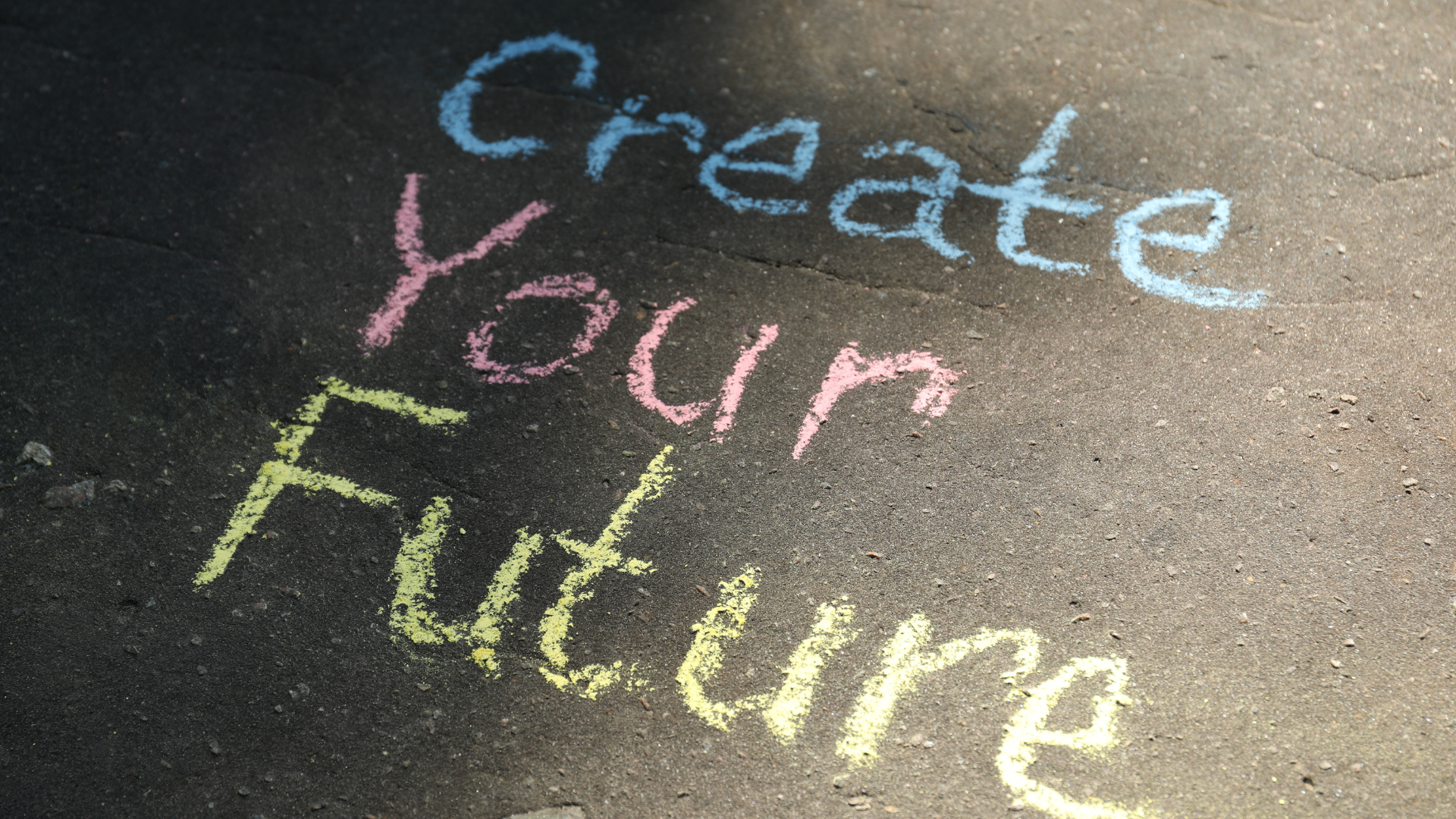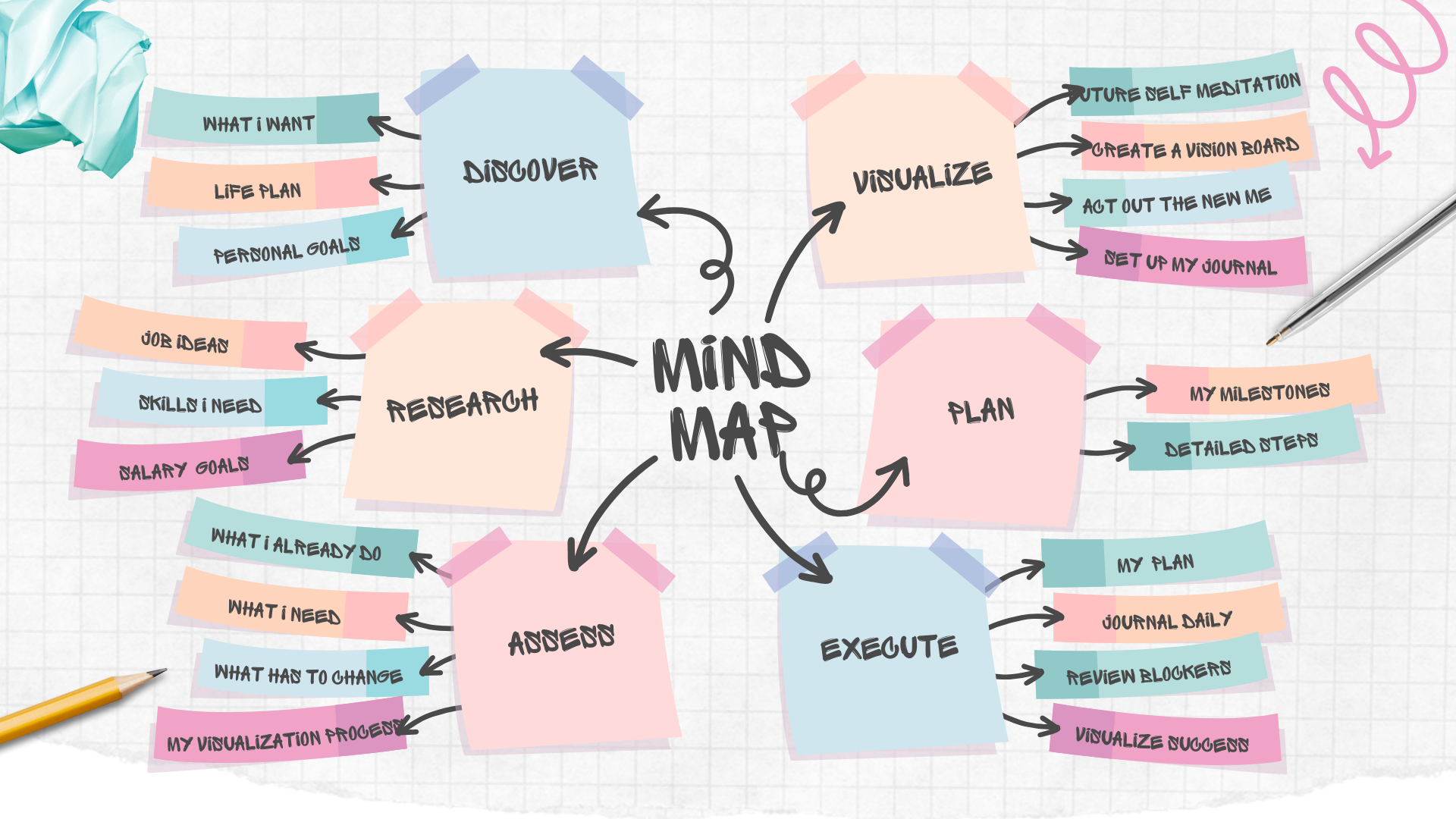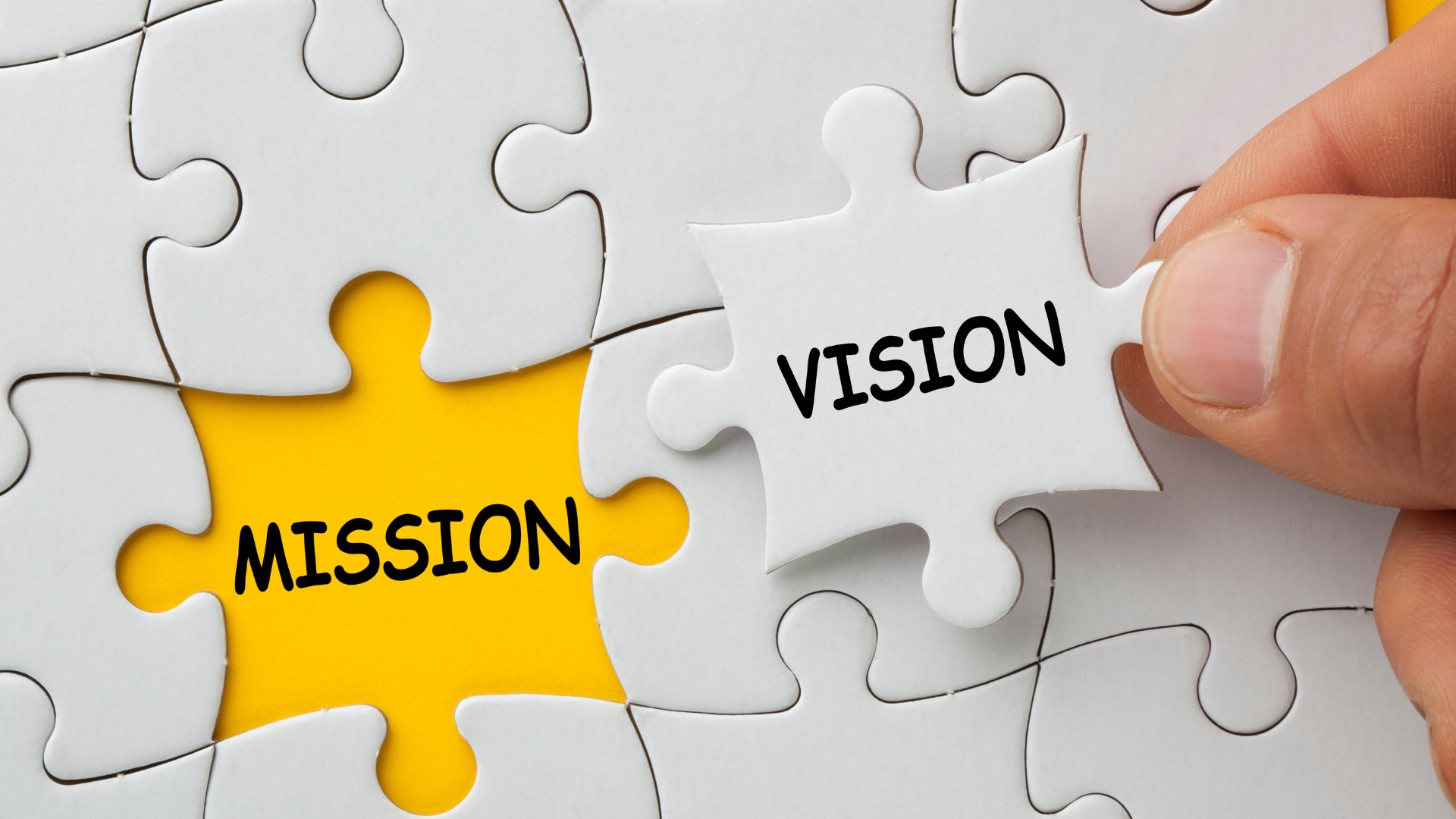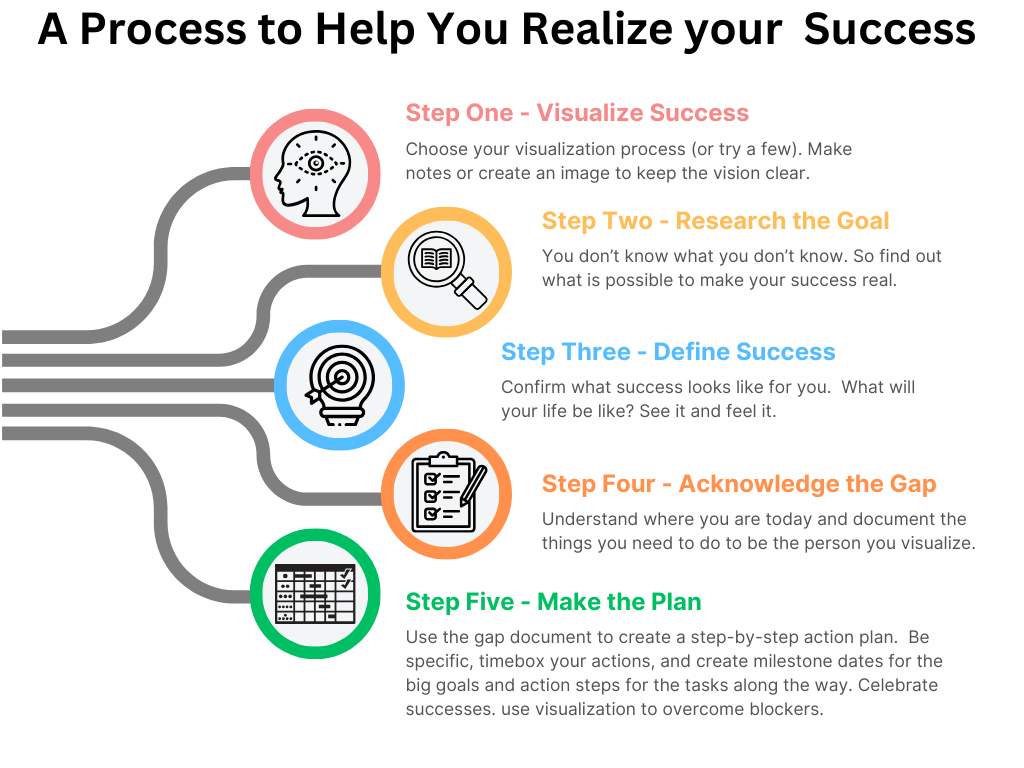How to Visualize Your Success | 5 Ways that Work
Achieving success requires more than hard work and determination. It also calls for a strategic mindset and the ability to envision your goals. Visualizing for success is a powerful technique that harnesses the power of the mind to manifest your desired outcomes.
5 Visualization tools to try
Vision Boards
Guided Imagery
Journaling
Role Playing
Mind Mapping
Do you feel stuck? Maybe you are afraid of failure. Worrying about failure can put you in the wrong state of mind to succeed. If you are:
looking for a new job
starting a new role at work
assigned to a new project team
or have a test coming up
The secret to success lies in the power of visualization! Imagine your success first, then take action. Visualization is not just a technique; it's a transformative power that can help you manifest your dreams and goals. Our brains are hard-wired for visualization. Creating vivid mental images of success can enhance motivation, focus, and overall performance.
Which to choose? Visualization styles vary depending on the person, the context, and the topic. One of these tools may work best for you, or you may use all of them. These visualizations allow you to think beyond where you are today and to take action to make your dream a reality.
Understanding the Power of Visualization
According to a University of Chicago Study, visualization can improve performance by up to 23%.
Visualization is not just a feel-good technique; it's a scientifically proven method. It activates the same neural pathways in the brain as actual experiences, reinforcing positive beliefs and boosting confidence. When you envision your success, you create a clear image of your own. This helps you stay focused on your goals and primes your brain to recognize and seize opportunities that can help you achieve them, making it more likely for your visualized success to become a reality.
Visualizing success is a life skill you can use regularly, not just at the big moments in life. Like mentally working out, visualizing activates the subconscious mind, aligns your thoughts and actions, and increases motivation and focus. Numerous studies have demonstrated the effectiveness of visualization in various fields, including sports, business, and personal development.
5 Visualization Methods that Work
Vision Boards
Vision boards are physical or digital collages representing your goals and aspirations. Gathering images, quotes, and symbols that align with your vision of success creates a visual reminder of what you want to achieve.
Regularly viewing your vision board reinforces your motivation and keeps your goals in mind.
A study conducted at the Dominican University of California found that people who wrote down their goals and created visual representations (vision boards) were 42% more likely to achieve them.
Vision Boards are often used by project teams and individuals with specific goals who want to focus on the steps needed to achieve them. Research has found that vision boards are more successful at taking small steps toward the larger goal.
This simple tool works. I found this when preparing for a hike to Kilimanjaro, Africa's highest mountain. Seeing my vision board with a 'stick figure picture' of me on the summit with a list of daily workouts and nutrition I needed to prepare helped me achieve my goal.
“A dream written down with a date becomes a goal. A goal broken down into steps becomes a plan. A plan backed by action makes your dreams come true.”
Guided Imagery
Sometimes, this technique is called guided visualization. This practical technique involves using pre-recorded or self-created visualizations to guide your mind toward specific goals.
If you're preparing for a job interview, you can visualize yourself confidently answering questions and impressing the interviewer. This approach can enhance focus, reduce anxiety, and increase confidence, making it a powerful tool in your goal-achievement arsenal.
A study published in the Journal of Consulting and Clinical Psychology found that guided Imagery can reduce stress levels by up to 30%.
A deeper meditation process I have used is "the Future Self Journey." This method helps you look beyond today and define a new future. I have a script and video to guide you through the meditation if you want to try this approach. I have modified this approach to help mentees work through test anxiety or build the confidence to ask for a raise. You can use the script as a jumping-off point to make the future mediation open or specific.
“Imagination is the beginning of creation. You imagine what you desire, you will what you imagine, and at last, you create what you will.”
Journaling
Daily writing can effectively visualize goals and track the actions needed to make them a reality. Journaling can also improve mindfulness. It can act as a mental exercise that keeps us happy and healthy.
Journaling helps us navigate life's challenges and daily activities. Depending on how we journal, it can create awareness, focus, creativity, or calm. By expressing thoughts and feelings in a journal, we can gain clarity, insight, and perspective and develop a more positive and resilient mindset.
Various types of journaling fit a specific purpose. Some examples are:
Gratitude journaling - reminds you to appreciate your life
Reflection journaling - improving awareness of your thoughts and experiences
Daily journalling - focuses on noting each day's activities
According to Positivepsychology.com, studies show that time spent journaling about our deepest thoughts and feelings can even reduce the number of sick days we take off work.
I use a form of journaling that combines many of the formats. My focus is to assess progress toward goals. I also want to understand how I feel and what I need and celebrate daily successes in life. Download the Daily Journal and start journaling today.
“Journal writing, when it becomes a ritual for transformation, is not only life-changing but life-expanding.”
Mental Rehearsal and Visualization Role Playing
Mental rehearsal involves mentally practicing and visualizing yourself, completing tasks, or achieving specific goals. You enhance your confidence, decision-making, and overall performance by vividly imagining the process and outcome. Athletes, musicians, and professionals often use this technique to improve their skills.
A study published in the Journal of Sports Sciences revealed that mental rehearsal can improve performance by up to 45%.
Visualizing often works best when it involves all our senses: movement, sight, listening, and writing. I like to go further and act it out or do visualization role-playing. When working on a project, the team can workshop a process, role-play actions, and try out processes. I like having the team walk around, organizing papers to present work handoffs. We can check communications using team members to represent customers, services, and supporting roles. By doing this, the team can work through issues, improve their way of working, and build a joint vision of success.
Visualize success - Act it Out!
Cliff Divers uses physical visualization before each dive. When it's over in a second, imprinting the process and the vision of success is critical. We use similar approaches when preparing for a 'business pitch' or starting to network at an event.
Molly is a YouTuber and a champion diver, finder her @RedBullCliffDiving
“Visualization lets you concentrate on all the positive aspects of your game.”
Mind Mapping
3 Steps to Creating your Own Mind Map
Define the main goal, put that at the center of your map
Create headings for each different idea part of the main goal
List the subpoints below to link actions to the ideas
When using mind mapping, I find that pen and paper are part of my visualization process, but you can also use a tool to update and share your mind map. You can get started for free with tools like Canva or Miro.
Like vision boards, mind mapping is a great tool for visualizing. But mind mapping has the extra benefit of allowing you to capture the detailed steps needed to accomplish a bigger, more complex goal. A mind map is a diagram representing related goals with specific tasks or ideas related to that goal. This method works well for project teams and for task—and word-oriented people.
A study conducted by Indiana University found that mind mapping improved medical students' ability to generate creative ideas and solve problems.
I have used this technique in projects when the team was almost to the finish line, but many key areas needed to come together to make the go-live date. Our project used formal planning, of course. However, dealing with the difficult last-minute work of integrating various teams and content required mind mapping. Together, the full team and I would use flip charts to document the areas of work (functional, technical, interfaces, etc.) and the final steps needed to bring the work together into a system ready to go live. The process of everyone using markers to hand draw their key tasks and noting common touchpoints and issues became our visual plan to execute this final critical process. This collaborative approach not only made the process more efficient but also fostered a sense of unity and shared responsibility among the team members. This approach also uses another ‘hidden visualization,’ which I call "Be the Teacher." Teaching someone else is a great way to visualize your own success since teaching others requires competence in a specific area. When we allow others to teach us, we help them to reinforce their mental mind map on the process. Using the flip chart with the team reviewing the critical steps to go live was a way of doing that.
“A picture is worth a thousand words, but a mind map is worth a thousand pictures.”
How to go from Vision to Mission
Use these 5 steps to make your Visualization into reality. See my video on how to make a simple plan here to get started.
Visualization is not just a concept; it's a real-world tool for achieving success and realizing your goals. Whether through guided Imagery, vision boards, or mental rehearsal, the power of visualization can significantly impact your motivation, focus, and performance. Take these approaches, harness the data-backed benefits, and unlock your potential to turn your dreams into reality. The power is in your hands.
If you want to know more about the process of moving from visualization to goal. See the video on visualization and the process shown here.
If you are ready to try visualization, see my guide to creating a life plan or taking the future self-journey.
I have much more content on my channel to help you set goals, build confidence, find a mentor and more. Use my videos, articles, and downloadable documents to make your transformational start today!









